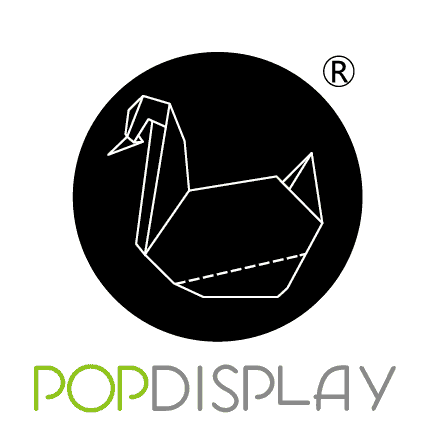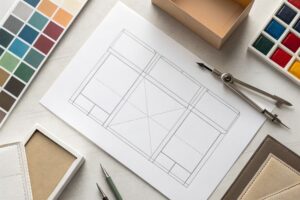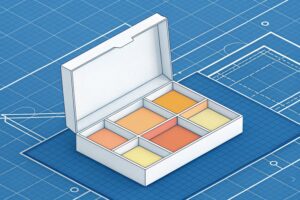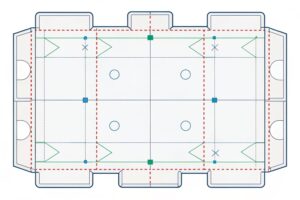I see many brands struggle. They want speed. They want cost control. They want green choices. I solve this with a simple, clear order path.
Order custom display boxes by defining goals, locking specs, approving a 3D render and sample, testing strength, confirming print, and scheduling mass production with a firm delivery plan and QC checkpoints. Keep budgets, timelines, and certifications aligned at each step.
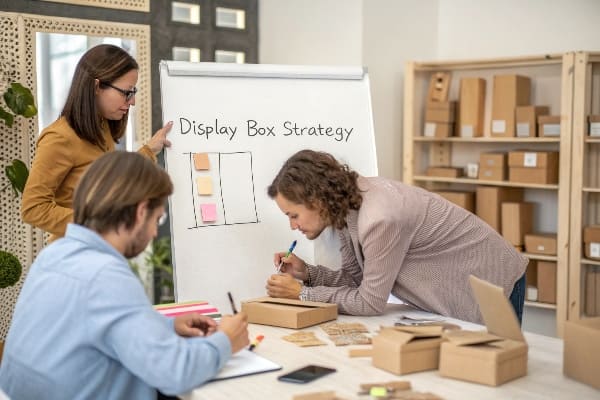
I guide buyers with short steps. I reduce confusion. I keep each step visible. You know cost, time, and risk in advance. You avoid delays and rework. You also get displays that sell.
What are custom display boxes?
Many teams ask for “custom” and then copy a template. The design looks fine. The shelf impact is weak. I start with the product story and the retail setting, not the box.
Custom display boxes are purpose-built cardboard structures that hold, present, and promote products in-store or at events, with tailored size, structure, artwork, print finish, and strength to match the product, brand goals, and the retailer’s rules.
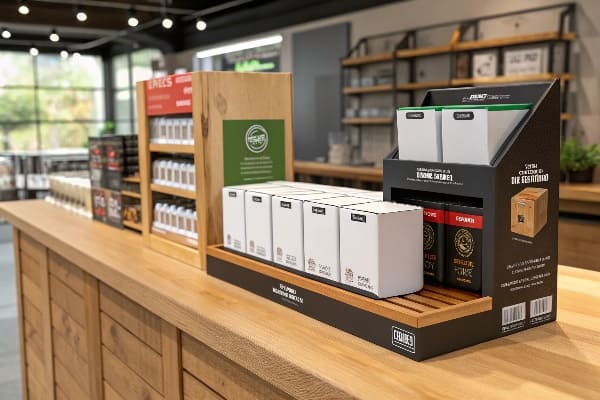
Types, goals, and fit
I match structure to channel. I design for speed and cost. I protect the product too. I draw from my shop floor. I run three lines in Shenzhen. I have a design-to-prototype workflow1 with free revisions. I test loads and transport. I have learned simple rules: clear message, easy setup, strong corners. I also prepare documents for retail compliance.
Structure spectrum
| Type | Best use | Notes |
|---|---|---|
| Floor display (FSDU) | Large launches, high traffic | Big impact, higher board grade |
| Countertop (CTU) | Impulse, small packs | Fast setup, low freight cost |
| Pallet display | Club stores, promo | Ships as unit, stable footprint |
| Shelf tray / PDQ | Grocery, pharmacy | Fits planogram, easy restock |
| Clip strip / hang tab | Light SKUs | Cheap, quick placement |
| Interactive add-ons | Demos, AR, QR | Boosts engagement, adds cost |
Design levers
Size and load
I set size to product and planogram. I fix load paths with supports. I add tabs where staff pull. I keep flat-pack friendly.
Print and finish
I pick digital for short runs and fast turns. I pick litho-lam for brand colors. I add water-based inks and matte or soft-touch if needed.
Sustainability
I use recycled liners and FSC board when asked. I avoid hard-to-recycle laminates. I propose lightweight, strong designs to cut fiber and freight.
I saw one crossbow accessory launch fail in a big-box test. The stand looked great. The base bowed under stacked cartons. I rebuilt with a double-wall base and hidden ribs. The sell-through jumped. The buyer extended the program.
How much does it cost to make a cardboard box?
Teams want a single price. The truth changes with size, board grade, print, and run size. I give ranges fast, then lock numbers after a sample and ship test.
Simple trays can cost $0.40–$2 each in volume. Branded countertop units run $3–$8. Floor displays with full graphics often cost $25–$90, depending on size, board grade, finishing, and quantity. Tooling is usually low or waived with repeat orders.
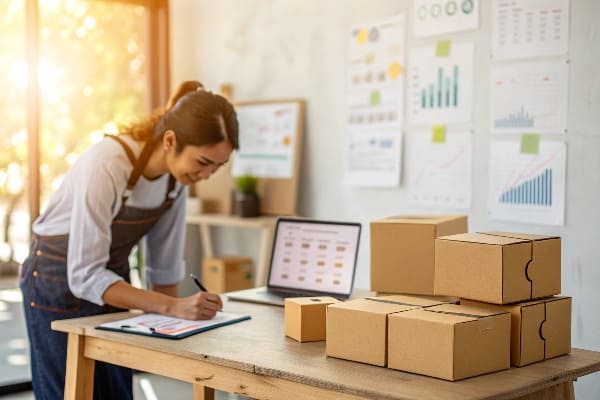
What drives cost, and how to control it
I build cost from a short formula. I start with board yield. I add print passes. I add die-cut and glue. I add pack-out time. I add outer cartons and pallets. I add freight and duties. I then remove waste with design tweaks.
Cost model (plain terms)
| Cost Block2 | Typical Drivers | How I Optimize |
|---|---|---|
| Board & yield | Footprint, cut layout, flute | Tight nesting, lighter but strong grade |
| CMYK + specials, coverage | Digital for short runs, limit spot colors | |
| Die-cut & glue | Complexity, hand work | Fewer pieces, auto-glue locks |
| Finishes | Lamination, varnish, foil | Water-based varnish, selective effects |
| QC & tests | Load, ISTA ship tests | Early prototype tests prevent rework |
| Logistics3 | Flat-pack rate, cube | Fold-flat design, pallet plan |
| Tariffs & duties | Market policy shifts | Source materials smart, plan HTS codes |
Quick quoting method
1. I confirm target unit price band.
2. I confirm MOQ and rollout schedule.
3. I provide two options: “value” and “premium.”
4. I run a sample to confirm yield and strength.
*5. I fix the price for the run with a variance cap.
Material markets move. In 2025, pulp and energy show swings. Some buyers face new tariffs. I protect budgets with lighter structures and better nesting. I also plan split shipments to hit deadlines without air freight.
What are the benefits of custom boxes?
Buyers ask for ROI. They want proof. I link design to sell-through, setup speed, and freight savings. I track these after each launch.
Custom boxes increase shelf impact, protect products, speed setup, lower freight cubes, and support sustainability claims. They also align with retailer rules, reduce damages in transit, and help brands tell a clear story at the point of purchase.

How custom wins in the real world
I serve FMCG, beauty, and outdoor brands. I see similar patterns. Clear messaging sells. Easy setup helps staff. Strong corners cut damages. Lightweight saves freight. Green claims matter, especially in Europe and North America. In Asia-Pacific, speed and scale matter more. The region grows fast with urban retail and e-commerce.
Benefit map
| Benefit | Proof point | Design choice |
|---|---|---|
| Sales lift | Better facing, brand block | Tall headers, bold claims |
| Faster setup | Less labor, fewer parts | Tool-less locks, numbered panels |
| Lower damage | Fewer returns | Reinforced bases, corner posts |
| Freight cut4 | More units per pallet | Flat-pack, compact die lines |
| Compliance | Smooth onboarding | Planogram fit, test reports |
| Sustainability5 | Consumer trust | Recycled fiber, water-based inks |
Regional notes
North America
Mature retail. Stable demand. Compliance rules are strict. Club stores like pallet displays. Speed matters for seasonal drops.
Europe
Sustainability leads. Buyers ask for FSC, recycled content, and low-VOC inks. Minimal design works well.
Asia-Pacific
Fast growth. 2022 packaging value was strong. Brands push quick turns and big volumes. Digital print supports trials.
I recall a hunting tools launch. The buyer needed strict deadlines. We used a PDQ tray for small accessories and a floor unit for hero SKUs. We hit the set date. We designed flat-pack so freight cost dropped. The client reordered with minor tweaks.
What are custom retail boxes?
Many people mix “shipping box” with “retail display.” A custom retail box sells first. Protection comes next. I design to guide the eye, not just to hold weight.
Custom retail boxes are branded, shelf-ready packages that combine protection and presentation, sized to retailer rules, printed for impact, and engineered for quick setup by store staff or merchandisers.
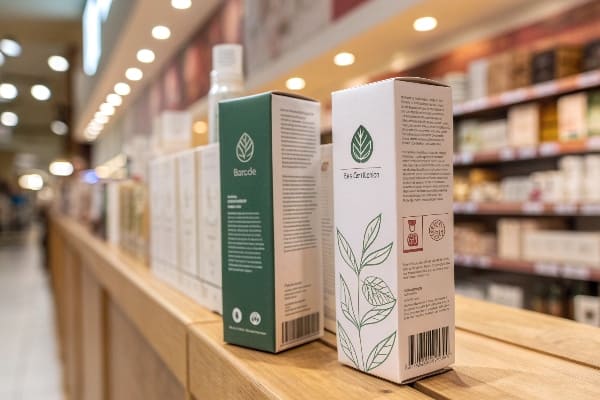
Retail rules, speed, and sustainability
I design for planograms and store labor. I follow SRP standards. I test tear-away fronts. I make sure barcodes scan after the front is removed. I keep tray lips low for easy pick. I keep color consistent with ICC profiles and drawdowns. I run water-based inks and recyclable varnish.
Retail box checklist
| Area | Questions I ask | Outcome |
|---|---|---|
| Size | Does it fit the bay? | No overhang, stable stack |
| Access | Can staff open fast? | 10–30 second tear line |
| Facing | Is branding readable? | High-contrast logo zone |
| Strength | Does it survive ship? | Verified load path |
| Color | Do tones match brand? | Controlled proofs |
| Green | Can it be recycled? | Mono-material board |
Speed to market
My five-day sample loop
Day 1: I lock dieline.
Day 2: I print art on final stock.
Day 3: I cut and glue.
Day 4: I run load and ship tests.
Day 5: I issue a video setup guide.
Future trends I build in now
Smart QR for stories and warranty. AR try-ons for beauty. IoT tags for stock checks. Nano coatings for water and scuff. Modular parts for reuse. Asia-Pacific growth keeps pushing short runs and fast pilots. Europe keeps pushing recyclable designs6. Floor displays keep growing because impact is clear to shoppers.
I once fixed a color drift problem for a multi-store drop. The client saw blue shift under store lights. I built a light booth match and adjusted profiles. Reprints stopped. The brand kept the rollout on time.
Conclusion
Order with clear goals, locked specs, strong tests, and simple setup. You get impact, speed, and control. Your displays sell products and protect budgets.
Understanding the design-to-prototype workflow can enhance your product development process, ensuring efficiency and quality. ↩
Understanding cost blocks is crucial for optimizing production expenses and improving profitability. ↩
Exploring logistics strategies can reveal ways to reduce costs and enhance efficiency in your supply chain. ↩
Discover effective strategies for cutting freight costs in packaging, essential for improving profit margins. ↩
Explore this link to understand how sustainability is shaping packaging trends in Europe, crucial for staying competitive. ↩
Exploring this resource will provide insights into how recyclable designs can enhance sustainability and appeal to eco-conscious consumers. ↩
